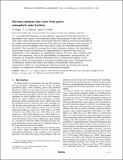Deriving emissions time series from sparse atmospheric mole fractions
Author(s)
Rigby, Matthew; Ganesan, Anita Lakshmi; Prinn, Ronald G.
DownloadPrinn_Deriving emissions.pdf (161.3Kb)
PUBLISHER_POLICY
Publisher Policy
Article is made available in accordance with the publisher's policy and may be subject to US copyright law. Please refer to the publisher's site for terms of use.
Terms of use
Metadata
Show full item recordAbstract
A growth-based Bayesian inverse method is presented for deriving emissions of atmospheric trace species from temporally sparse measurements of their mole fractions. This work is motivated by many recent studies that have deduced emissions using archived air samples with measurement intervals of the order of a year or longer in the early part of the record. Several techniques have been used to make this underdetermined problem invertible. These include the incorporation of prior emissions estimates, the smoothing of observations or derived emissions, the approximation of emissions time series by polynomials, or the application of regularization schemes. However, these methods often suffer from limitations, such as the unavailability of independent, unbiased priors, the emergence of unrealistic emissions fluctuations due to measurement outliers, or the subjective choice of measurement or emissions smoothing time scales. This paper presents an alternative solution that reduces the influence of potentially biased priors or measurement outliers by constraining the emissions growth rate around some growth estimate, in conjunction with the model-measurement mismatch.
Date issued
2011-04Department
Massachusetts Institute of Technology. Center for Global Change ScienceJournal
Journal of Geophysical Research
Publisher
American Geophysical Union
Citation
Rigby, M., A. L. Ganesan, and R. G. Prinn. “Deriving Emissions Time Series from Sparse Atmospheric Mole Fractions.” Journal of Geophysical Research 116, no. D8 (2011).
Version: Final published version
ISSN
0148-0227